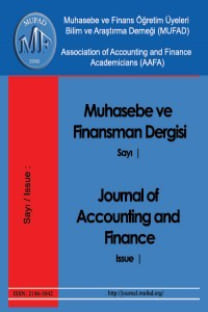Yeni Bir Maliyet ve Yönetim Muhasebesi Yöntemi Olarak Kaynak Tüketim Muhasebesi
1980’lerden itibaren geleneksel hacim tabanlı maliyetleme yöntemlerinin doğru mamul maliyeti hesaplamada başarısız olması nedeniyle geliştirilen Faaliyet Tabanlı Maliyetleme (FTM) yöntemi, akademik alanda üzerinde çok çalışılan ve önerilen bir yöntem olmasına rağmen uygulamada beklenen ilgiyi görmemiştir. Karmaşıklığı, oluşturulması, sürdürülmesi ve değişiklik yapılması zor bir sistem olduğu gerekçeleriyle eleştirilen FTM yönteminin yerine, yeni nesil maliyetleme yöntemleri önerilmeye başlanmıştır. Kaynak Tüketim Muhasebesi (KTM) bu yöntemlerden biridir. KTM, FTM ile Alman maliyet muhasebesi sisteminin (GPK) bileşiminden oluşan yeni bir yönetim muhasebesi sistemidir. FTM’de maliyetlerin kaynağı faaliyetler olarak görülürken, KTM’de maliyetleri kaynakların doğurduğu önermesi vardır. Bu nedenle, KTM’de odak noktası kaynaklardır. Öte yandan, KTM maliyet davranışlarına göre kaynak maliyetlerini sabit ve orantısal olarak gruplandırmakta ve atıl kapasite maliyetlerinin hesaplanmasına olanak tanımaktadır. Hesaplanan atıl kapasite maliyetleri mamullere dağıtılmamakta, böylece mamuller tüketmedikleri kaynaklardan pay almamaktadır. Bunun sonucunda, yöneticilere karar verme süreçlerinde kullanabilecekleri ayrıntılı ve doğru maliyet bilgileri sunulmaktadır. Çalışmanın amacı, yönetim kararları açısından son derece önemli olan maliyet bilgilerini elde etmede kullanılabilecek yeni bir yönetim muhasebesi yöntemi olarak KTM’yi gelişimi, unsurları ve maliyet dağıtım süreciyle açıklamaktır. Çalışmada, öncelikle KTM’nin gelişimi ve unsurları anlatılmış, ardından hipotetik bir örnek üzerinden kaynak maliyetlerinin maliyet objesi olarak mamullere dağıtımı hem FTM hem de KTM yöntemi kullanılarak yapılmıştır. Böylece, bu iki yöntem arasındaki farklılıklar ortaya konularak bu yeni yöntemin amacı, unsurları, avantajları ve dezavantajlarıyla birlikte incelenmiştir.
Anahtar Kelimeler:
Maliyet Bilgisi, Kaynak Tüketim Muhasebesi, Faaliyet Tabanlı Maliyetleme, Alman Maliyet Muhasebesi.
Resource Consumption Accounting As A New Management And Cost Accounting Method
Although it has extensively been studied and recommended in academic area, Activity-Based Costing (ABC), which has been developed since 1980s because traditional volume-based costing methods failed to calculate accurate product cost, is not attracted anticipated attention in practice. New generation costing methods started to be recommended instead of ABC that is criticized because it is a complicated and a hard to be formed, maintained, and modified system. Resource Consumption Accounting (RCA) is one of those methods. RCA is a new management accounting system that is a mixture of ABC and German cost accounting system (GPK). There is a hypothesis that resources create costs in RCA while the origin of costs is activities in ABC. Because of this, focus is on recourses in RCA. On the other hand, RCA classifies resource costs as fixed and proportional according to cost behavior and enables to calculate idle capacity costs. Calculated idle capacity costs are not allocated to the products, so products do not receive a share from resources they did not consume. As a result of this, detailed and accurate cost information can be provided to the managers in their decision making processes. The aim of this study is to explain RCA with its evolution, components, and cost allocation process as a new management accounting method, which can be used to obtain highly important cost information for management decisions. In this study, first of all RCA’s evolution and its components are explained. Then out of a hypothetic example, allocation of resource costs to the products as a cost object are made using both ABC and RCA methods. Thus, new method’s aim, components, advantages, and disadvantages are investigated by displaying the differences between two methods.
Keywords:
Cost Information, Resource Consumption Accounting, Activity-Based Costing, German Cost Accounting.,
- ISSN: 2146-3042
- Yayın Aralığı: Yılda 4 Sayı
- Başlangıç: 2005
- Yayıncı: Muhasebe ve Finansman Öğretim Üyeleri Derneği (MUFAD)
Sayıdaki Diğer Makaleler
İnşaat Sözleşmelerinin Finansal Tablolarda Sunuluşuna Yönelik Kullanılan Yöntemlere Bakış
İştirak Yatırımlarının Muhasebeleştirilmesi
Muhasebe Manipülasyonu ve Muhasebe Bilgi Kalitesine Etkisi
Türkiye’deki Halka Açık Konaklama Şirketlerinin Muhasebe Politikalarının Belirlenmesi
Katılım ve Geleneksel Bankaların Finansal Performanslarının Karşılaştırılması: Türkiye Örneği
Portföy Çeşitlemesi: İMKB’de Sektörel Endeksler Üzerine Bir Analiz
Ayhan KAPUSUZOĞLU, Mustafa İBİCİOĞLU
Yeni Bir Maliyet ve Yönetim Muhasebesi Yöntemi Olarak Kaynak Tüketim Muhasebesi
Faaliyet Tabanlı Maliyetleme Yönteminin Yükselişi ve Düşüşü
Hastanelerde Performans Ölçümünün Muhasebe Bilgi Sistemiyle İlişkilendirilmesi
